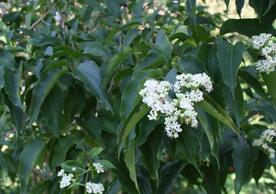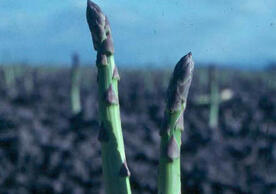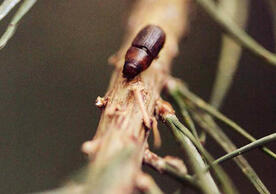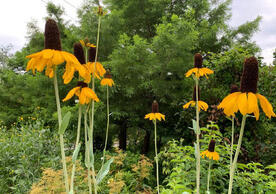China Fir
(Cunninghamia lanceolata)
ID – Evergreen, needles spirally arranged, main axis standing out all around stem, those on underside turn upwards so they appear to spring from side, needles sharply pointed, 1”-2 ¾” long, stomata on underside surrounding midrib, bark – brown scaling off, exposing reddish inner bark.
Features – 30’-75’ tall, 10’-30’ wide, slow/medium growth, needles may turn bronze in cold weather, cones ovoid, 1 ½” wide, usually in groups
Story – Native to southern and central China where it is a highly prized tree, wood is light, soft and fragrant, almost white, used for indoor carpentry, box making and masts, rot resistant
Evergreen Collection
Monkey Puzzle Tree
Japanese Umbrella Pine
Scotch Pine
Douglas Fir
Sequoia
Japanese Stewartia
(Stewartia pseudocamellia)
ID – Alternate, oblong-elliptic leaves, 2”-3” long, distinctive “camouflage” bark, mix of grays, browns and orange
Features – 20’-40’ tall, white camellia-like flower in Jul, fall leaf color – yellow-purple
Story – Native to Japan, similar to native Mountain Stewartia, but has more attractive bark
Flowering Dogwood
(Cornus florida)
ID – Opposite oval leaves, 3”-6” long, bark – brown/black blocks on mature trees, like alligator’s back
Features – 20’ tall and wide, slow growth, flowers – white or pink bracts in Apr/May, 2” long, often appear before leaves, fruit – glossy red 1/3”-1/2” ovoid in clusters of 3 or 4, appearing in Sep/Oct, fall leaf color – red/purple
Story – Native – MA – FL – ON – TX, prefers partial sun to full sun, can become stressed in hot dry location and be victimized by diseases such as anthracnose, hundreds of hybrids which offer greater disease resistance and varieties of flower and leaf color
Beautyberry
(Callicarpa bodinieri)
ID – Opposite, elliptical leaves, 2”-5” long
Features – 6’x10’ tall and wide, striking purple fruit in fall, fall leaf color – pinkish purple
Story – Native to China, 1” lilac flowers in summer, effective as mass border planting
Common Witchhazel
(Hamamelis virginiana)
ID – Alternate ovate leaves, 3”-6” long, 2”-3” wide, young stems zig-zag
Features – 20’-30’ tall and wide, fragrant yellow follower sin Nov, good yellow fall color
Story – Native – CAN-GA-NE-AK, grows in moist, shady stream banks, extract from bark of young stems and roots manufactured in CT
Fothergilla
(Fothergilla gardenia)
ID – Alternate, oblong leaves, 1”-2 ½” long, stem zig-zag slender light brown
Features – 2’-3‘ tall„ white, fragrant bottlebrush flowers 1” dia in spring before leaves emerge, great fall leaf color – light orange to deep red
Story – Native to SE US, often found in pine groves and around pond, thrives in sun and well drained soil
Virginia Sweetspire
(Itea virginica)
ID – Alternate, oblong – elliptical leaf, 1 ½” -4” long, stem green to reddish purple
Features – 3’-5’ tall, medium growth, fall leaf color – florescent red, flowers – white, fragrant, 2”-6” long racemes in May/Jun
Story – Native to NJ – FL – MO – TX, usually found in wet woodlands, but drought tolerant
Dawn Redwood
(Metasequoia glyptostrobiodes)
ID – Opposite, soft light green needles, cinnamon brown vertically exfoliating bark
Features – 70’ – 100’ tall, very fast growing, tolerant of wet areas, deciduous conifer, needles turn bright copper color in fall
Story – Believed to be extinct until 1940s when found by Chinese botanists(1941), seeds shared with Arnold Arboretum (Harvard)(1947), propagated and now widely available in garden centers
Fossil evidence suggests tree is 100M years old, native to North America 15M years ago
American Yellowwood
(Cladrastis kentukea)
ID – Alternate pinnately compound leaf, 5-11 leaflets, 8”-12” long, no terminal bud, bark – thin, gray beech-like (unless grizzled with age)
Features – 30’-50’ tall, fragrant white flowers in pendulous panicles, 12”-18”, in May
Story – Name derived from appearance of freshly cut heartwood, native - NC – KY – TN, river valleys and limestone slopes along rivers, growing successfully in MN and ME
Tuliptree
(Liriodendron tulipfera)
ID – Alternate square shaped lobed leaves, Bark – grayish-brown, furrowed interlacing flattened ridges, grayish crevices
Features - Flower – tulip-like, greenish/yellow petals, interior orange, fast growing, often lower branches fall off,
Story - One of tallest native trees in eastern forest (190’), King of Magnolia family, sent to Europe by colonists in 1600s, very light wood, Daniel Boone made a 60’ canoe to move his family, often cut by colonists to create farm land – presence was a sign of fertile soil
Sugar Maple
(Acer saccharum)
ID – Opposite, palmate leaves 3”-6”, clear sap from petiole, bark – thin gray on young trees, long irregular thick plates on mature trees, U-shaped samaras
Features – 50’-75’ tall, slow-medium growth, fall color – spectacular burnt orange to red, sap tapped in late winter for syrup (40 gal=1 gal syrup)
Story – Native to Eastern Canada-MN-GA, not a good urban tree-intolerant of pollution, salt, restricted growth areas, excellent wood for furniture
Sour Gum/Tupelo
(Nyssa sylvatica)
ID – Alternate, ovate/elliptical leaf, 3”-6”, bark – dark, block-like appearance
Features – 30’-50’ tall, consistently great fall color – fluorescent yellow/orange, deep tap root, slow growth
Story – Native –ME–MI–TX–FL, grows in swampy woods, poor timber tree, very difficult to split, fibers interwoven and cross-braided (unusual), decays in contact with ground, used as a handle on heavy duty tools, gunstocks
Sweetgum
(Liquidambar styraciflua)
ID – Alternate, star shaped, 5 lobed, fruit – brownish capsules, woody, spiny, 1”-1 ½”
Features – 60’-75’ tall, medium to fast growth, fall color – purple/red, name derived from sweet tasting sap which has a gummy consistency, used in soaps and incense, balsam-like odor, grows best on rich moist soils near rivers,
Story - in South invades abandoned fields, CT northern end of native range, Alexander Hamilton wanted it to become USA’s emblematic tree, no state has chosen it
Fern Leaf Beech
(Fagus sylvatica ‘Asplenifolia’)
ID – Alternate leaves, gracefully cut to offer fern-like appearance, 2”-4” long, 1”-2” wide, smooth gray bark
Features – 50’-60’ tall, slow/medium growth, fall color – russet-bronze, leaves emerge later, generally more disease tolerant than American Beech
Story – Native to Europe
Seven Son Flower
(Heptacodium micronioides)
ID – Opposite, oblong pointed leaf, 3”-6”, bark – gray/brown, exfoliating revealing lighter inner bark
Features – Fragrant white flowers in August
Story – Native to China, introduced by Arnold Arboretum (Harvard) originally on 1907, more recently in 1980, name originates from flower which is six tiered whorl panicle terminated with another flower
River Birch
(Betula nigra)
ID – Alternate triangular wedge shaped leaves, peeling white/salmon colored bark
Features – 40’-60’ tall, fast growing, tolerant of wet areas, yellow fall color, bark offers winter interest
Story – Native to New England – MN – TX – N. FL, borer-resistant, heat (but not dry) tolerant
Franklin Tree
(Frankinia alatamaha)
ID – Alternate, oblong oval, 5”-6” long, 3” wide, bark – smooth gray with vertical fissures
Features – 10’-20’ tall, medium growth, large white fragrant flowers (3” across) in Jul – Aug - Sep, fall color – red/purple, fruit – woody, ½”-3/4” capsule
Story – Found in John Bartram in 1770 along Altamaha River in GA, he collected several samples, tree has been not been seen in wild since 1803, great specimen tree for landscape but difficult to establish. Cause of extinction:
1. Small population – vulnerable to natural disasters – hurricane, flooding
2. Killed by introduced pathogen related to cotton farming
Winterberry
(Ilex verticillata)
ID – Alternate deciduous, 1 ½”-3”long, 1” wide leaves
Features – 6’-10’ tall and wide, bright red ½” berries in fall
Story – Native – NS-WI-FL-MO, slow growth, will tolerate shade and moist ground, although better fruit set in sun, dozens of cultivars and hybrids
Oakleaf Hydrangea
(Hydrangea quercifolia)
ID – Opposite, oak leafed shaped leaves, 3-7 lobes, 3”-8” long, bark – exfoliating cinnamon with prominent lenticels
Features – 4’-8’ tall and wide, white fragrant flowers, changing to purplish/pink, Jun/Jul, borne on 4”-12” tall, 3”-4” tall and 3”-4” wide panicles, persistent, fall color – red/purple
Story – Native to SE US, many different cultivars varying in size
Bald Cypress
(Taxodium distichum)
ID – Deciduous alternate needles, bright green, bark – reddish/brown fibrous. trunk buttressed in wet areas, usually featuring “knees” – purpose of which is not understood
Features – 50’-70’ tall, medium/fast growth, fall color – soft orange/brown, thrives in wet areas
Story – Native – DE – MO – TX – FL, successfully grown in MN and Southern Canada
Royal Purple Smoke Bush
(Cotinus coggygria “Royal Purple”)
ID – Alternate oval shaped leaf, 1 ½”-3 ½” long, maroon red becoming dark purple/black, stem – brownish/purple
Features – 10’-15’ tall, flowers morph into 6”-8” long panicles of smoky pink hairs in June, medium growth, fall color – rich red/purple
Story – Native to Europe – Himalaya - Central China
Hardy Orange
(Poncirus trifoliate)
ID – Alternate three part rounded elliptical leaf, 1”-2 ½” long, stem – glossy green, thorns at nodes
Features – 8’-20’ tall, slow growth, fall color – yellow/green, flowers – white, 5 petaled in May, fruit – yellow berry 1 ½” across, soft downy covering, ripens in Oct, very sour
Story – Used as a hedge in South, thorns deter traffic, native to China and Korea, fruit, although seedy, can be used for marmalade and candied peel
American Smoketree
(Cotinus obovatus)
ID – Leaves longer (2”-5”), bluish green leaves
Features – Larger (20’-30’), great fall color – yellow, orange, amber red
Story – Native to SE US, but Zone 4-8





